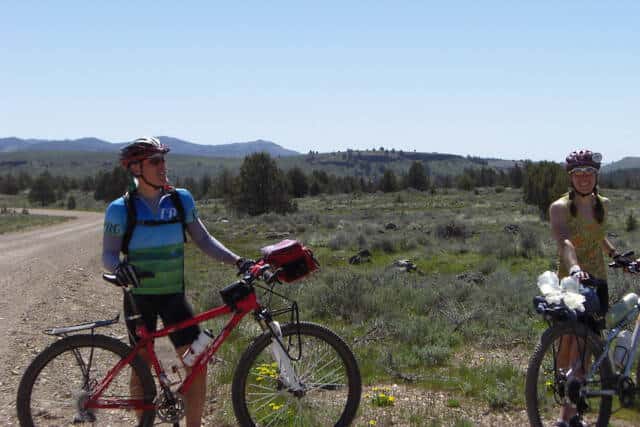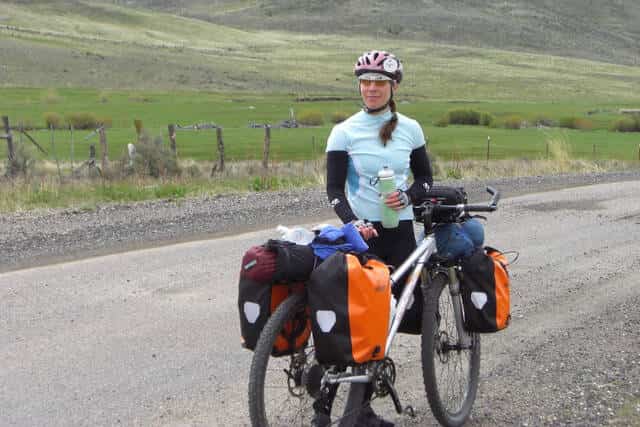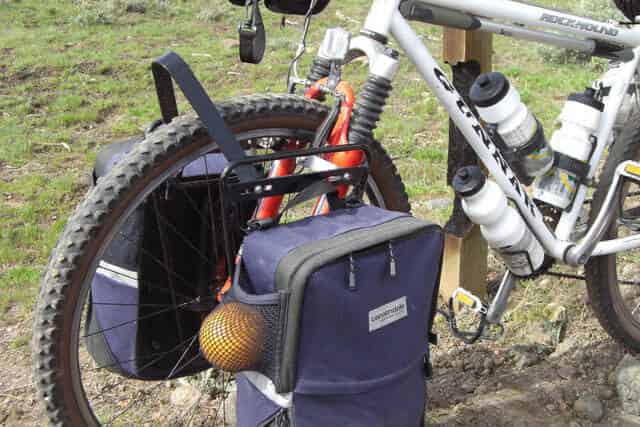The one-word answer to your query “Are Mountain Bikes Good for Touring?.” is Yes. Although mountain bikes are specially designed to run on rugged terrains, it is also suitable for a long-distance trip.
The MBT is powerful, can deal with the most challenging roads; professional riders even prefer these bikes. Riding a mountain bike requires a little bit more pedaling, but by installing the right tires & handlebar, you can ensure a smooth, comfortable long ride.
In this article, we’ll discuss the benefits of opting for a mountain bike over a traditional one: the various shortcomings you are unaware of.
We’ll also talk about the accessories you need to install on your conventional bike to translate it into a mountain bike. Finally, we’ll put forth pro tips for riding a mountain bike for a long tour.
So, without wasting any time, let’s find.

Benefits of Using MTB for Touring
There are a myriad of benefits that comes with picking a specialist mountain bike over a traditional bike, and here we’ll talk about this in detail:-
Responsive Geometry
In contrast to the conventional bikes, the frame of an MTB has a more responsive geometry with a steeper steering angle, a higher bottom bracket, shorter chainstays & wheelbase; no matter what road you ride on — smooth city roads or rugged trails — you can depend on an MTB for a safe and comfortable ride always.
Lightweight
Another of the most compelling advantages of using mountain bikes is they are light in weight and deliver better acceleration, irrespective of the road type. An MTB promises a submissive ride with vibration absorption, and you’d love the dead-drop after a steep road.
Tested to Perfection
The MTBs are resilient & rugged, designed by qualified engineers to ensure unparalleled safety. In comparison to our convection bikes, these bikes are rigorously tested to provide the latest cutting-edge riding experience that most bikers want.
Plenty of Accessories
Not only are the MTBs available in a vast selection of design options, but there are also a wealth of accessories in the market. All these accessories aim to make your ride safe and pleasant on any terrain. Explore the Internet or a local bike store to discover the widest range of accessories.
Better Control
An MTB with full suspension has a wider wheelbase. It enables the cyclists to balance & control at higher speeds and greater angles at any given surface.

Disadvantages of using Mountain Bike For Touring
Besides the many advantages, there are some drawbacks of mountain bikes that you need to know:-
Less Durable Aluminum Frame
Typically, the frame of most mountain bikes is made out of aluminum, which doesn’t deliver as much vibration dampening. The aluminum frame is way more prone to structural fatigue than traditional bikes’ steel framing. The aluminum frame, over time, develops cracks or even worse.
Straight Handlebars
The straight handlebars don’t allow for various hands position during a long tour, which could lead to hand and arm fatigue or, even worse, potential hand nerve damage because of the extended compression of the ulnar nerve.
High Costs
It is one of the critical drawbacks of mountain bikes. The MTBs are way more expensive in contrast to the conventional bike. You overcome this by opting for a basic design mountain bike with limited features.
Suspension Could be a Problem
The high suspension of mountain bikes is ideally not preferred for long flat rides. The suspension i’s objective to absorb the shock from rough terrain, bumps, tree roots, and rocks. However, the modern mountain bikes come with a lockout, which gives cyclists the freedom to disable the suspension wherever they want to.
Saddle Pain
If you ride the bike for a lengthy time, it will hurt. Therefore, it is imperative that you break-in your saddle and ride as much as possible before your extended trip. All this will allow you to get used to the saddle and save you from frustration and pain. Opt for seamless pans to avoid any friction.
Why Are Old Mountain Bikes Better Suited For Touring? ( mid 80’s and early 90’s models )
You must have heard those stories from your parents about how mountain bikes in the ’80s used to be at a different level, you can take them on trails or go out for touring; it will adapt. Yes, without a dilemma, the mountain bikes of the 80s and 90s were better suited for long trips.
First, the wheelbase of the MTBs in that golden era used to have a wheelbase 26″, which provided better full control and safety than the 29″ wheelbase of the latest mountain bikes.
Second, the frame of MTBs is quite robust, stays in shape even after years of rough and tough use. The MTBs back then didn’t have any suspension; therefore, riding them on a smooth ride was no hassle.
Although the mountain bikes have improved considerably over the past two decades, the old is gold when it comes to long-distance trips.
The modern MTBs are a little lightweight, therefore, very much less stable than the old mountain bikes. The mountain bikes of the 80s and 90s were built to last for years, whereas the latest MTBs are quite delicate and require better care and maintenance.
How Far Can You Ride on a Mountain Bike
As a matter of truth, there is no thumb role in how far you can ride your mountain bike. By making a few tweaks, you can make it suitable for a long-distance trip.
These include increasing the tire pressure for low rolling resistance. You must swap out the conventional tires of MTBs with slicker ones for flat road use.
For hands comfort, go with a stem raiser; this will present you with a more upright position, just like a hybrid bike. If you expect no hills or climbs in your journey, then don’t forget to lock out the fork; this will ensure you don’t lose all your energy to suspension.
You can add a paneer rack so that you don’t have to carry the weight on your shoulders. All this will ensure that your long ride on a mountain bike is a comfortable experience for life.
Before you take your mountain bike straightway for a long ride, it is imperative to ensure that you do a lot of practice to strengthen your muscle to deal with stiffness and cramps.

MTB to Touring Bike Conversion?
Mountain biking has long been associated with budget bike travelers, especially during the 80s and 90s when rigid bikes were greatly preferred.
Even today, many adventurers prefer to refurbish an old MTB rather than invest in a high-end model.
Before you begin modifying your old mountain bike and converting it to a bike suitable for flat roads and long trips, it is imperative to ensure that the bike you pick is in decent condition with a strong base.
Otherwise, all your efforts and money will go in vain. Here are a few upgrades you need to make for a long tour, so let’s find out:-
Install the Road Tires
Typically, the old mountain bikes come with 2.5-inch tires, which are quite knobby. These tires provide better safety and firm grip that works fine for off-road terrains but certainly slow on a flat road.
Therefore, it is best to swap these knobby tires touring ones to better efficiency and minimize flats’ likelihood. Opt for road tires available in widths, ranging from 1.25 inches to 2 inches.
For a fast tire setup, go with slick tires to provide a better riding experience on flat terrain. The 1.5-inch slick tires that fit your wheel are best recommended.
Swap Out Handlebars
The mountain bikes come with flat bars. The biggest problem with this type of handlebar is that it only provides a one-hand position, and for touring, it is best to have various hand positions.
It improves comfort during long trips. So, swap the flat handlebars with a different type of handlebars, such as trekking bars, are a popular option.
Install Fenders
The fenders are best-suited for keeping you, your mountain bike, and your gear clean when riding on wet roads. They are worth adding to increase your drivetrain’s life by keeping it cleaner.
Install Racks
The least expensive and the most convenient way to haul your gear is with a pannier and rack set up. There are various affordable rack options available in the market; choose one that complements your bike’s aesthetic appeal, fits wells, and matches your purpose of adding racks.
Upgrade the Saddle
Since you’ll be spending too much time in the saddle when touring, therefore, it is best if you replace it with a more comfortable option. The leather saddles are most widely advised for touring.
Install a Mirror
Another key to translating your mountain bike into a work that delivers a smooth long-distance ride is a mirror. It will allow you to easily see the approaching cars as they pass by.
Add Lights & Bottle Cages
If you plan to ride in the late evening or early morning, then adding lights is necessary for safety. To stay hydrated during your long tour, add one or two water bottle cages.
Clipless Pedals or Install Platforms
To improve your mountain bike’s efficiency, it is highly recommended to swap your pedals out for clipless ones. You can even consider installing large platform pedals for improved comfort.
Remove Suspension
The MTBs are built to absorb impact from rocks, terrain, and tree roots. These bikes have suspension, which is advisable for off-road riding but frustrating for riding on the road.
It would be great to have a lockout; it is an easy adjustment to make before heading onto the road. In case there is no option for lockout, then the best alternative is to increase the suspension’s air pressure to stiffen it up. It reduces any bobbing while you pedal and stand to sprint or climb.
A rigid fork will make your bike lighter and stiffer for efficient road riding.
Minor Position Changes
It is advised to drop your handlebars slightly lower if you’ll be doing a lot of road riding, without much switching between road setups and mountains.
The road riders opt for lower handlebars for better aerodynamics, while mountain bikers prefer higher handlebars for enhanced handling.
While lowering the stem on the steer tube is generally a job of a couple of seconds, it helps you out of the wind swiftly. Make sure that your body adapts to the new position, and it changes how much pressure you’ll have on your hands and could cause more saddle as the bike hinges forward.
Stuff to Bring
Before you get rolling on a long bike tour, here is a quick checklist to keep in mind:-
What Essentials Do You Require?
- Emergency Contact Info
- Water Bottle or Hydration Pack ( Buy On Amazon )
- Sunglasses or Clear Lenses ( Recommended: X-TIGER Polarized Sports Sunglasses )
- SPF 15 Sunscreen
- Smartphone, GPS, or Route Map
What Bike Accessories for Long-Distance Touring You Require?
- Handlebar Bag ( Buy This On Amazon – The One I personally Use )
- Bike Lock ( Anti-Theft Bike Lock – Get It Now ! )
- Flashing Tail Light
- Rain Covers And/or Plastic Bags ( Tip: Buy One That Best Fit Your Needs )
What Repair Items You Require?
- Spare Disc Brakes/brake Pads
- 2 Extra Spokes
- Spare Nuts, Bolts, and Washers
- Bike Cleaning Wipes
- Spoke Wrench
- Repair/Duct Tape
- Bike Pump ( Buy All In One Portable Bike Repair Kit )
What Misc You Require?
- Basic first aid kit ( Buy On Amazon )
- Camera + Accessories
- Toilet Paper/tissue
Draft a checklist a day before you hit the roads, and make sure you adhere to it.
Let’s Wind Up
So, we’ve reached the end of the article; we hope you like the information we provided, right from the many advantages of using a mountain bike, a couple of flaws, to critical tips on how to make your ride smooth.
It is best to prepare your mountain bike for flat terrains, such as installing a stem raiser for a comfortable grip and preventing nerve damage. It is highly recommended that you lock out the suspension.
Therefore you’ll have a hard time riding your bike on a flat road. Do you want to share your personal experience of riding a mountain bike for long-distance touring?
Share it with us in the comment section below or via contact us form, we’d love to hear from you.
Happy Riding!
Also Read,
Complete Guide To Bike Touring For Beginners
Touring Bike vs Mountain Bike: 11 Major Differences









Leave a Reply